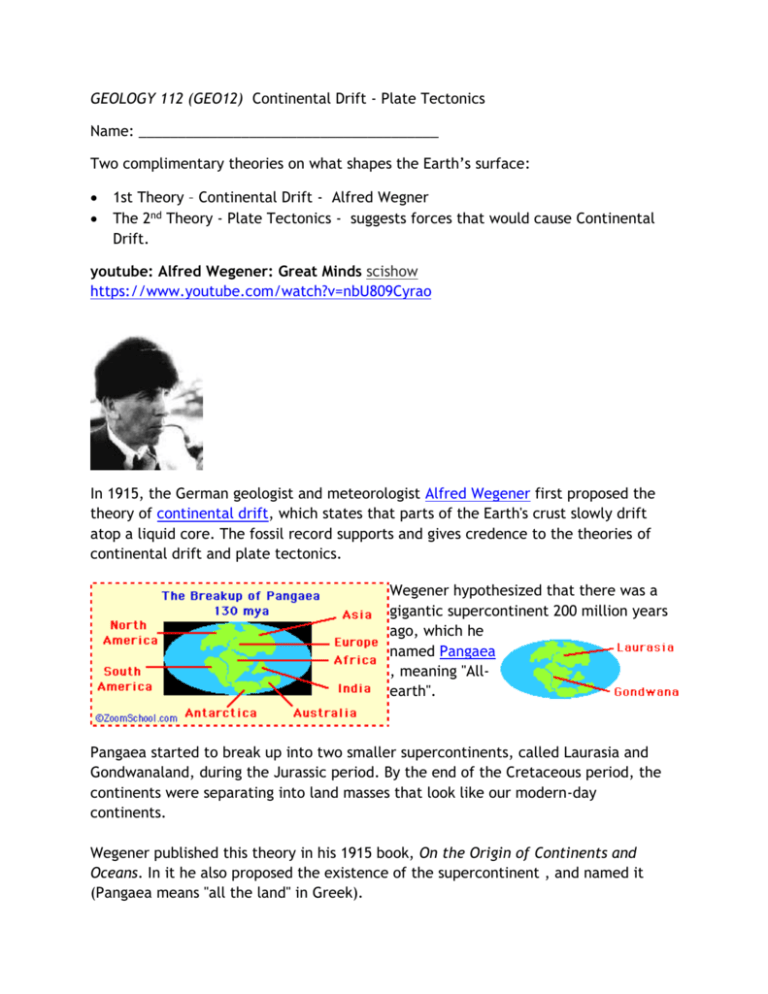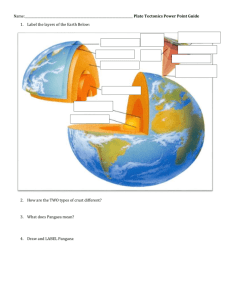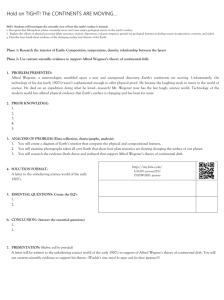Continental Drift - Plate Tectonics
advertisement

GEOLOGY 112 (GEO12) Continental Drift - Plate Tectonics Name: ______________________________________ Two complimentary theories on what shapes the Earth’s surface: 1st Theory – Continental Drift - Alfred Wegner The 2nd Theory - Plate Tectonics - suggests forces that would cause Continental Drift. youtube: Alfred Wegener: Great Minds scishow https://www.youtube.com/watch?v=nbU809Cyrao In 1915, the German geologist and meteorologist Alfred Wegener first proposed the theory of continental drift, which states that parts of the Earth's crust slowly drift atop a liquid core. The fossil record supports and gives credence to the theories of continental drift and plate tectonics. Wegener hypothesized that there was a gigantic supercontinent 200 million years ago, which he named Pangaea , meaning "Allearth". Pangaea started to break up into two smaller supercontinents, called Laurasia and Gondwanaland, during the Jurassic period. By the end of the Cretaceous period, the continents were separating into land masses that look like our modern-day continents. Wegener published this theory in his 1915 book, On the Origin of Continents and Oceans. In it he also proposed the existence of the supercontinent , and named it (Pangaea means "all the land" in Greek). Everyone laughed at Wegener. Obviously the continents couldn’t move! What force could be big enough to move a continent? Besides Wegner was just a weatherman. Plate Tectonics Before WWII the ocean bottom was thought to be mostly flat and featureless. During World War II a Princeton professor named Harry Hess was a captain of a transport in the Pacific. He kept records of the fathometer (depth sounder) reading everywhere he went. After the war he mapped the Pacific Ocean bottom revealing mountains, trenches, plains, etc. He devised the theory of sea-floor spreading, and suggested that convection cells in the earth’s mantle caused the movement. A Canadian geophysicist named John Tuzo Wilson put the whole thing together – the plate tectonic theory with all its details, especially the theory of “Wilson Cycles.” In Wilson Cycles ocean basins open and close over hundreds of millions of years. The ocean crust is continually recycled, and older continental crust rides on top. The theory of plate tectonics (meaning "plate structure") was developed in the 1960's. This theory explains the movement of the Earth's plates (which has since been documented scientifically) and also explains the cause of earthquakes, volcanoes, oceanic trenches, mountain range formation, and other geologic phenomenon. The plates are moving at a speed that has been estimated at 1 to 10 cm per year. Most of the Earth's seismic activity (volcanos and earthquakes) occurs at the plate boundaries as they interact. Type of Average Average Major Crust Thickness Age Component Continental 20-80 3 billion Granite Crust kilometers years Hundreds Oceanic 10 of Basalt Crust kilometers millions of years The top layers of the plates are called the crust. Oceanic crust (the crust under the oceans) is thinner and denser than continental crust. Crust is constantly being created and destroyed; oceanic crust is more active than continental crust. TYPES OF PLATE MOVEMENT: Divergence, Convergence, and Lateral Slipping At the boundaries of the plates, various deformations occur as the plates interact; they separate from one another (seafloor spreading), collide (forming mountain ranges), slip past one another (subduction zones, in which plates undergo destruction and re-melting), and slip laterally. Read section 9.1; Pages 248 to 253 When was the hypothesis of continental drift first proposed? Who made the proposal? What did Wegner’s continental drift hypothesis state? What did he call the last supercontinent? What does Pangea mean? Briefly (no more than two sentences) summarize the evidences that Wegner used in his proposal Evidence – The Continental Puzzle Evidence – Matching Fossils Evidence – Rocks and Structures Evidence – Ancient Climates Why did most people reject Wegner’s hypothesis? What was missing?








